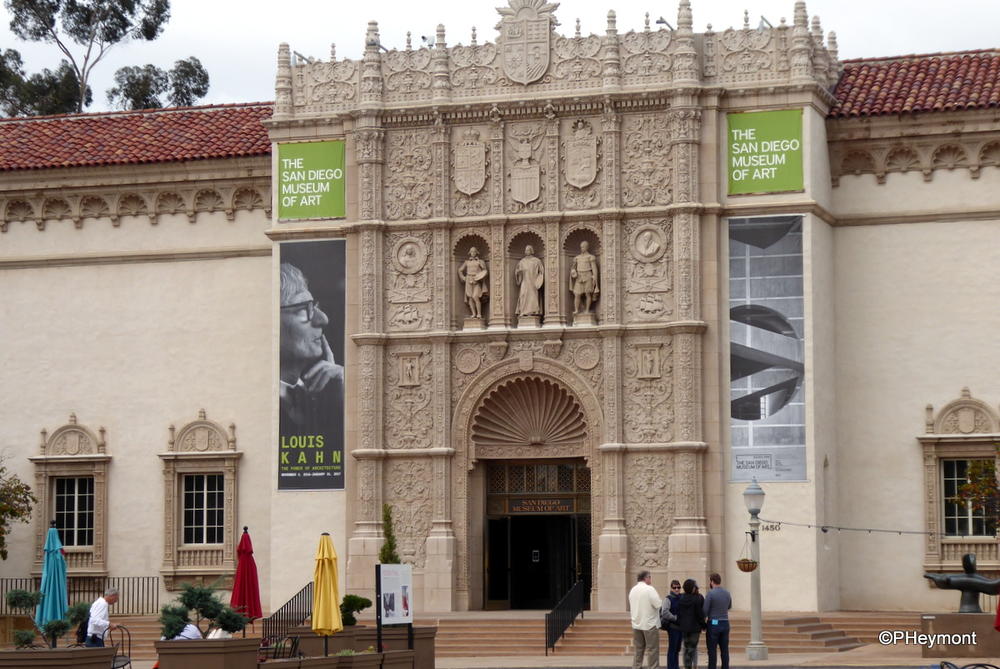Where Gumbo Was #204
San Diego’s Balboa Park is one of the best-known parks in the U.S., not least as home of the San Diego Zoo. It’s also one of the oldest; the land was set aside in 1835, when California still belonged to Spain.


But for me, the best part of the park is the Prado, the long east-west axis that was the main exhibit area for the 1915 Panama-California and 1935 California-Pacific Expositions. The amazing assembly of ornate buildings, a National Historical Landmark since 1976, is now home to over a dozen of the park’s 17 museums, and to the San Diego Botanical Garden.


With such a well-known location, it’s not surprising that we had successful guessers: the unbeatable George G and GarryRF, both of whom worked the puzzle by closely watching details of decoration and style. Perhaps soon they’ll take turns as The Puzzler and try the rest of us out!

 Although, actually, in a number of cases what you see is not what was there for the fair. Fire and neglect took a toll on a number of the buildings. Two had to be rebuilt for 1935, and in the 1990s, several were demolished and rebuilt from the original plans—surely a wise decision!
Although, actually, in a number of cases what you see is not what was there for the fair. Fire and neglect took a toll on a number of the buildings. Two had to be rebuilt for 1935, and in the 1990s, several were demolished and rebuilt from the original plans—surely a wise decision!


I have to admit that until my visit last month, I had no idea the Prado even existed. On a previous visit to Balboa Park, years ago, we had wandered through open areas, and had spent an afternoon at the zoo, standing in a long line to see the pandas, and to be disappointed they were not stunningly black and white like the stuffed toys.


This time, my goal was a visit to the incredible San Diego Model Railroad Museum, of which more in another blog. The museum is located on the lower level of one of the buildings, with the San Diego History Center and its library on the floors above.


I was dropped off at a street entrance to the park that actually serves other parts and only passes behind the service entrances of the Prado buildings; with direction from passers by, I turned off the parking lot and was stunned to find myself with this first view, looking ahead to the Botanic Garden’s greenhouse, and then out onto the street of ornate wonders. Even on a drizzly morning, it was a spectacle.

Not just the buildings themselves, of course, but a variety of features, plazas, fountains and more…
With all that activity going on, this info-kiosk, and others like it, were kept pretty busy. But busy has other meanings for some, like the small boy who spent quite a bit of time with the water feature, dropping leaves and twigs in and just watching.
At the Natural History Museum, there’s a huge banner with the slogan “If you’re going to explore San Diego, start 75 million years ago. Had I but the time!
This scene (remember it from the clues?) gave the impression of a place much older than it actually is…and in fact many of the buildings seem far older than 100 years because of their references to Spanish colonial styles.
And there are birds to be seen; this one stayed while his companions scattered at the sound of people approaching. In life, it looked blacker than this, and I think crow.
The Botanic Garden’s greenhouse, with its distinct color, stands to one side of the Prado, with a lovely small pool in front of it. Another ‘I wish I had had time’ item for a future visit!
A bit further down, I came to the San Diego Museum of Art, one of several art museums in the park. On a warmer day, I’m betting the seats around the tiled fountain are popular. I can feel the future visit list building…

The San Diego Art Institute is in a building once called the House of Charm for the 1935 fair.
Nearby, the Prado Restaurant offers ‘fine dining’ as well as a place for weddings and receptions. There are also a number of ‘casual dining’ option in several of the buildings.
At the western end of the Prado, near the arched gate that once marked the entrance to the expositions, there is this complex with its tower and dome…but it’s not a church and never was.

It houses the San Diego Museum of Man, and it’s the only building of the Prado complex that’s still being used for its original purpose. The building went up in 1915 to house the exposition’s iconic exhibit: The Story of Man through the Ages, with artifacts from the Southwest, Mexico and many other areas.
As the exposition prepared to close a group of local citizens formed the San Diego Museum Association and took over, keeping most of the original exhibit and developing it into a museum of anthropology. It took its present name in 1942. The adjoining tower houses a carillon.









































































Looks like an amazing place to visit. I wish they would show more of these hidden gems on the “Visit America” ad’s on TV.
So much more to see of America – than a mouse with ears !